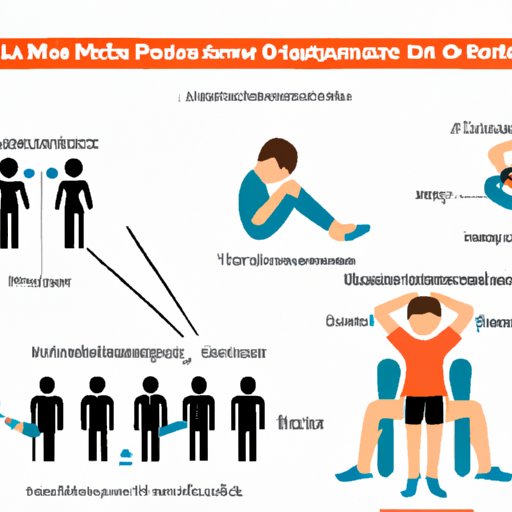
I. Introduction
Muscular dystrophy is a debilitating genetic disorder that affects the muscles. It causes progressive muscle weakness, leading to the loss of mobility, strength, and independence. The symptoms of muscular dystrophy can be challenging to deal with, but with early detection, proper management, and support, it is possible to live a fulfilling life with this condition. This article aims to provide an in-depth exploration of the various symptoms of muscular dystrophy, along with practical advice for managing the condition.
II. Unveiling the Signs: Understanding the Various Symptoms of Muscular Dystrophy
Muscular dystrophy symptoms differ from person to person, depending on the type of muscular dystrophy and the severity of the condition. However, some symptoms are common to all types of muscular dystrophy, and here is a brief overview of some of them:
Muscle weakness: is the most common and noticeable symptom of muscular dystrophy. It usually begins with the muscles of the hips, pelvis, thighs, and shoulders.
Abnormal posture: people with muscular dystrophy may have a characteristic way of standing or sitting, often leaning backward with an exaggerated curve in the lower back.
Trouble walking: as the muscles become weaker, walking becomes progressively more challenging. People with muscular dystrophy may start walking on their toes, have an unusual gait, or fall frequently.
Respiratory problems: some forms of muscular dystrophy can cause breathing difficulties, especially when sleeping. Over time, respiratory muscles weaken, and the risk of respiratory failure increases.
Heart issues: some types of muscular dystrophy affect the cardiac muscles, leading to heart failure or an abnormal heart rhythm.
Other symptoms of muscular dystrophy can include scoliosis (a curvature of the spine), difficulty swallowing, and vision problems.
Complications of muscular dystrophy can include joint contractures, which occurs when the muscles and tendons become tight, making it difficult to move. It can also cause muscle wasting, where the muscles break down and are replaced by fat and connective tissue.
III. Spotting the Warning Signs: 5 Key Indicators of Muscular Dystrophy
Early detection of muscular dystrophy is crucial for proper management of the condition. Here are some of the most common and recognizable symptoms of muscular dystrophy:
- Muscle weakness, especially in the hips, pelvis, thighs, and shoulders
- Trouble getting up from a sitting or lying position
- Waddling gait, or walking on toes
- Frequent falls
- Drooping eyelids or difficulty moving eye muscles
If you or a loved one experiences any of these symptoms, it’s essential to seek medical attention immediately. Early detection and diagnosis can help to slow down the progression of muscular dystrophy and improve the quality of life.
IV. Living with Muscular Dystrophy: A Survivor’s Guide to Managing Symptoms and Staying Healthy
A diagnosis of muscular dystrophy can be overwhelming, but with the right support and management strategies, it is possible to overcome the challenges. Here are some practical tips for managing muscular dystrophy:
- Keeping a healthy weight: maintaining a healthy weight can help to reduce the strain on the muscles and joints, making it easier to move.
- Physical therapy: physical therapy can help to maintain muscle strength and flexibility, improve balance, and reduce the risk of falls.
- Adaptive equipment: using adaptive equipment, such as braces, canes, wheelchairs, or power scooters, can help to maintain independence and mobility.
- Nutrition: eating a diet rich in fruits, vegetables, lean proteins, and whole grains can help to provide the energy needed to maintain muscle function.
- Establishing a support network: seeking support from family, friends, or community organizations can help to reduce the emotional burden of coping with the condition.
V. The Emotional Impact of Muscular Dystrophy: Coping with Symptoms and Staying Positive
Muscular dystrophy not only affects the body but also takes a toll on one’s emotional well-being. Coping with the symptoms and challenges of this condition can be overwhelming, leading to depression, anxiety, and grief. Here are some tips for coping with the emotional impact of muscular dystrophy:
- Be kind to yourself: allow yourself to feel a range of emotions and don’t be too hard on yourself.
- Seek professional help: talking to a counselor or therapist can help to manage negative emotions and provide coping strategies.
- Take breaks: taking time for oneself, engaging in hobbies or relaxation activities can help to reduce stress and improve emotional well-being.
- Finding a support group: join a support group of other people with muscular dystrophy, it can provide emotional support and advice.
- Have realistic expectations: learning to accept the limitations imposed by the condition and having realistic expectations can help to reduce stress and improve well-being.
VI. New Frontiers in Muscular Dystrophy Research: Hope for Effective Symptom Management and Treatment
Researchers are continually working on new methods for managing and treating muscular dystrophy. Advances in gene therapy, stem cell therapy, and drug therapies have shown promise in slowing down the progression of the condition and improving muscle function. Clinical trials are ongoing, and new treatments are emerging, giving hope for better symptom management and a possible cure in the future.
VII. Conclusion
In conclusion, muscular dystrophy is a challenging condition that affects many people worldwide. The symptoms can be debilitating, leading to reduced mobility and independence. However, with early detection, proper management, and support, it is possible to live a fulfilling life with this condition. We hope that this comprehensive guide has been useful in understanding muscular dystrophy symptoms and providing practical tips for managing the condition. Remember, don’t hesitate to reach out for support and care when needed.





